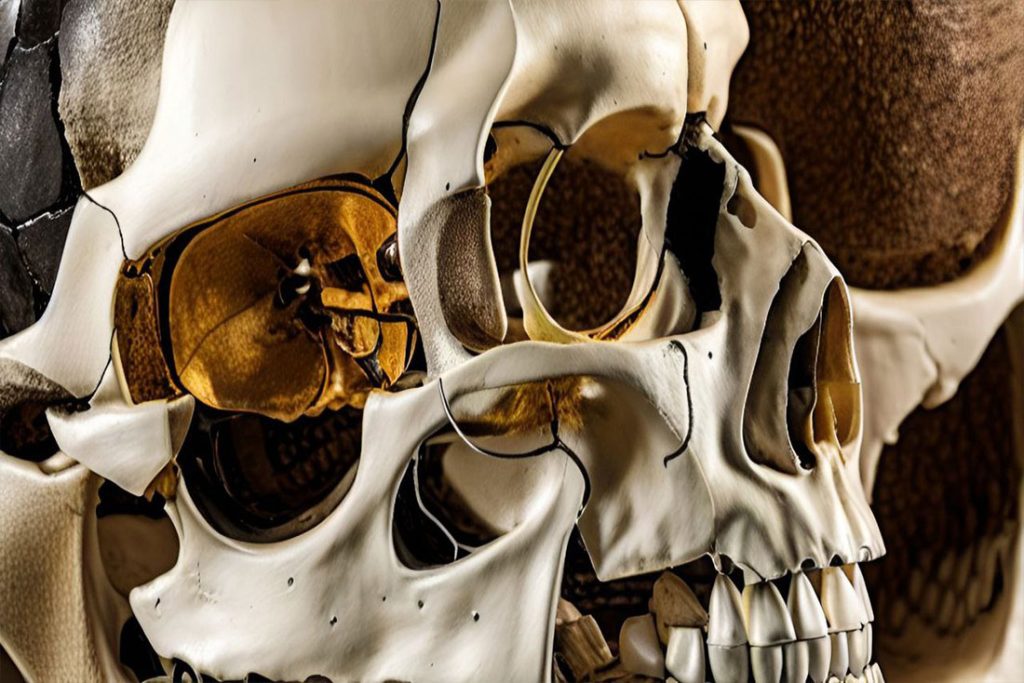The Intricate Structure of the Skull: Exploring the Cranium and Facial Skeleton
The skull is a vital component of the human body, serving as the protective framework for the head and its intricate structures. It can be divided into two main parts: the cranium and the facial skeleton. This article aims to provide a comprehensive overview of the skull’s composition, focusing on the eight bones of the cranium and the 14 bones that make up the facial skeleton.

Skull
The Cranium: Safeguarding the Brain
The cranium forms an oval-shaped, bony case that envelops and protects the brain. Comprising eight bones, the cranium is a vital structure for maintaining the integrity and functionality of the central nervous system. Key points about the cranium include:
1. Frontal Bone: The frontal bone forms the forehead and extends to the superior part of the orbits (eye sockets). It plays a crucial role in protecting the frontal lobes of the brain.
2. Parietal Bones: Two parietal bones form the superior and lateral aspects of the cranium. They meet at the sagittal suture, a fibrous joint that runs along the midline of the skull.
3. Temporal Bones: The temporal bones are located on the sides and base of the skull. They house important structures such as the middle and inner ear, as well as the temporomandibular joint (TMJ).
4. Occipital Bone: The occipital bone occupies the posterior part of the cranium and contains the large opening called the foramen magnum, through which the spinal cord passes.
5. Sphenoid Bone: The sphenoid bone is a complex, butterfly-shaped bone located at the base of the skull. It provides structural support and serves as an attachment point for various muscles and ligaments.
6. Ethmoid Bone: The ethmoid bone is situated between the orbital cavities and contributes to the nasal septum and the medial wall of the orbits.
7. Lacrimal Bones: Two small, delicate lacrimal bones form part of the medial wall of each orbit and contain a depression called the lacrimal fossa, which houses the lacrimal sac.
8. Nasal Bones: The nasal bones are two small, rectangular bones that join to form the bridge of the nose.
The Facial Skeleton: The Framework of the Face
The facial skeleton consists of 14 bones that provide structure and support to the face. These bones contribute to the formation of the facial features and facilitate essential functions such as breathing, eating, and speaking. Key points about the facial skeleton include:
1. Maxilla: The maxilla is the upper jawbone and forms the central portion of the facial skeleton. It contains the upper teeth and contributes to the formation of the hard palate, nasal cavity, and orbits.
2. Mandible: The mandible, also known as the lower jawbone, is the largest and strongest bone in the face. It supports the lower teeth and plays a crucial role in chewing, speaking, and facial aesthetics.
3. Zygomatic Bones: The zygomatic bones, commonly referred to as the cheekbones, form the prominence of the cheeks and contribute to the lateral walls of the orbits.
4. Nasal Bones: As mentioned earlier, the nasal bones form the bridge of the nose.
5. Vomer: The vomer is a thin, flat bone located within the nasal cavity, forming part of the nasal septum.
6. Palatine Bones: The palatine bones contribute to the formation of the hard palate, the bony roof of the mouth.
7. Inferior Nasal Conchae: The inferior nasal conchae are thin, scroll-shaped bones located on the lateral walls of the nasal cavity. They help humidify and filter inhaled air.
8. Lacrimal Bones: The lacrimal bones, as mentioned earlier, form part of the medial walls of the orbits.
The skull, comprising the cranium and facial skeleton, serves as the protective framework for the head and its vital contents. Understanding the composition and function of the eight bones of the cranium and the 14 bones of the facial skeleton provides insight into the intricacies of the human skull. By safeguarding the brain and supporting the facial features, the skull plays a fundamental role in preserving the integrity and functionality of the head. Further exploration of the skull’s anatomy is essential for healthcare professionals, researchers, and individuals seeking a comprehensive understanding of the human body’s remarkable structure.












